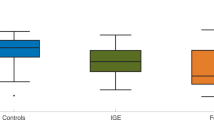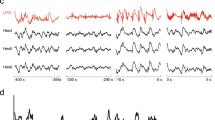Summary
Electrocorticograms (ECoG's) from 16 of 68 chronically implanted subdural electrodes, placed over the right temporal cortex in a patient with a right medial temporal focus, were analyzed using methods from nonlinear dynamics. A time series provides information about a large number of pertinent variables, which may be used to explore and characterize the system's dynamics. These variables and their evolution in time produce the phase portrait of the system. The phase spaces for each of 16 electrodes were constructed and from these the largest average Lyapunov exponents (L's), measures of chaoticity of the system (the larger the L, the more chaotic the system is), were estimated over time for every electrode before, in and after the epileptic seizure for three seizures of the same patient. The start of the seizure corresponds to a simultaneous drop in L values obtained at the electrodes nearest the focus. L values for the rest of the electrodes follow. The mean values of L for all electrodes in the postictal state are larger than the ones in the preictal state, denoting a more chaotic state postictally. The lowest values of L occur during the seizure but they are still positive denoting the presence of a chaotic attractor. Based on the procedure for the estimation of L we were able to develop a methodology for detecting prominent spikes in the ECoG. These measures (L*) calculated over a period of time (10 minutes before to 10 minutes after the seizure outburst) revealed a remarkable coherence of the abrupt transient drops of L* for the electrodes that showed the inital ictal onset. The L* values for the electrodes away from the focus exhibited less abrupt transient drops. These results indicate that the largest average Lyapunov exponent L can be useful in seizure detection as well as a discriminatory factor for focus localization in multielectrode analysis.
Similar content being viewed by others
References
Babloyantz, A. and Destexhe, A. Low dimensional chaos in an instance of epilepsy. Proc. Natl. Acad. Sci. USA, 1986, 83:3513–3517.
Babloyantz, A. and Salazar, J.M. Evidence of chaotic dynamics of brain activity during the sleep cycle. Phys. Let., 1985, 111A:152–156.
Campbell, D.K. Nonlinear Science-From paradigms to practicalities. Los Alamos Science, Special Issue, 1985, 15:218–262.
Eckmann, J. P., and Ruelle D. Ergodic theory of chaos and strange attractors. Rev. of Mod. Phys., 1985, 57:617–656.
Freeman, W.J. Simulation of chaotic EEG patterns with a dynamic model of the olfactory system. Biol. Cybernetics, 1987, 56:139–150.
Glass, L., Mackey, M.C. From Clocks to Chaos: The Rhythms of Life. Princeton University Press, 1988.
Gotman, J., Ives, J.R., Gloor, P. (Eds). Long-term monitoring in epilepsy. Electroenceph. and Clin. Neurophys., 1985, 35(suppl):93–201.
Grassberger, P. Information flow and maximum entropy measures for 1-D maps. Physica D, 1985, 14:365–373.
Grassberger, P. and Procaccia, I. Measuring the strangeness of strange attractors. Physica D, 1983, 9:189–208.
Grebogi, C., Ott, E., Pelikan, S., Yorke, J.A. Strange attractors that are not chaotic. Physica D, 1984, 13:261–268.
Grebogi, C., Ott, E., Yorke, J.A. Crises, sudden changes in chaotic attractors and transient chaos. Physica D, 1983, 7:181–200.
Holzfuss, J., Mayer-Kress, G. An approach to error estimation in the application of dimension algorithms. In: G. Mayer-Kress (Ed.), Dimensions and Entropies in Chaotic Systems-Quantification of Complex Behavior. Springer-Verlag, Springer Series in Synergetics, Berlin, 1986, 32:114–122.
Iasemidis, L.D., Zaveri, H.P., Sackellares, J.C. and Williams, W.J. Modelling of ECoG in temporal lobe epilepsy. 25th Ann. Rocky Mountain Bioeng. Symposium, 1988(a), 24:187–193.
Iasemidis, L.D., Zaveri, H.P., Sackellares, J.C. and Williams, W.J. Phase space analysis of EEG in temporal lobe epilepsy. IEEE Eng. in Medicine and Biology, 10th Ann. Int. Conf., 1988(b):1201–1203.
Jakobson, M.V. Absolutely continuous invariant measures for one parameter families of one dimensional maps. Comm. Math. Phys., 1981, 81:39–88.
Layne, S., Mayer-Kress, G., Holzfuss, J. Problems associated with the dimensional analysis of electroencephalogram data. In: G. Mayer-Kress (Ed.), Dimensions and Entropies in Chaotic Systems-Quantification of Complex Behavior. Springer-Verlag, Springer Series in Synergetics, Berlin, 1986, 32:246–256.
Li, T.V., Yorke, J.A. Ergodic tansformations from an interval into itself. Trans. Am. Math. Soc., 1978, 235:183–192.
Martin, S., Martienssen, W. Transition from quasiperiodicity into chaos in the periodically driven conductivity of BSN crystals. In: G. Mayer-Kress (Ed.), Dimensions and Entropies in Chaotic Systems-Quantification of Complex Behavior. Springer-Verlag, Springer Series in Synergetics, Berlin, 1986, 32:191–197.
Mayer-Kress, G., Holzfuss, J. Analysis of the human electroencephalogram with methods from nonlinear dynamics. In: L. Rensing, U. ander Heiden, M.C. Mackey (Eds.), Temporal Disorder in Human Oscillatory Systems, Springer Series in Synergetics, Springer-Verlag, Berlin, 1986, 36:57–68.
Ott, E. Strange attractors and chaotic motions of dynamical systems. Reviews of Mod. Phys., 1981, 53:655–671.
Packard, N.H., Crutchfield, J.P., Farmer, J.D. and Shaw R.S. Geometry from a time series. Phys. Rev. Let., 1980, 45:712–716.
Rapp, P.E., Albano A.M., Mees A.I. Calculation of correlation dimensions from experimental data: Progress and problems. In: J.A.S. Velso, A.J. Mandell, M.F. Schlessinger (Eds.), Dynamic Patterns in Complex Systems. World Scientific, 1988:191–205.
Rapp, P.E., Zimmerman, I.D. Albano, A.M., deGuzman, G.C., Greenbaum, N.N. and Bashore, T.R. Experimental Studies of chaotic neural behavior: cellular activity and electroencephalographic signals. In: H.G. Othmer (Ed.), Nonlinear Oscillations in Biology and Chemistry. Springer-Verlag, Berlin, 1986:175–805.
Romeiras, F.J., Bondeson, A., Ott, E., Antonsen, T.M. Jr., Grebogi, C. Quasiperiodically forced dynamical systems with strange nonchaotic attractors. Physica D, 1987, 26:277–294.
Swinney, H.L. Observations of order and chaos in nonlinear systems. Physica D, 1983, 7:3–15.
Takens, F. Detecting strange attractors in turbulence. In: D.A. Rand and L.S. Young (Eds.), Dynamical Systems and Turbulence. Lecture Notes in Mathematics. Springer-Verlag, Berlin, 1981:366–381.
Vastano, J.A., Kostelich, E.J. Comparison of algorithms for determining Lyapunov exponents from experimental data. In: G. Mayer-Kress, (Ed.), Dimensions and Entropies in Chaotic Systems-Quantification of Complex Behavior. Springer-Verlag, Springer Series in Synergetics, Berlin, 1986, 32:100–107.
Whitney, H. Differentiable Manifolds. Ann. Math., 1936, 37:645–680.
Wolf, A. Quantifying chaos with Lyapunov exponents. In: A.V. Holden (Ed.), Chaos. Princeton University Press, New Jersey, 1986:270–290.
Wolf, A., Swift, J.B., Swinney, H.L. and Vastano, J.A. Determining Lyapunov exponents from a time series. Physica D, 1985, 16:285–317.
Wolf, A., Vastano, J.A. Intermediate length scale effects in Lyapunov exponent estimation. In: G. Mayer-Kress (Ed.), Dimensions and Entropies in Chaotic Systems-Quantification of Complex Behavior. Springer-Verlag, Springer Series in Synergetics, Berlin, 1986, 32:94–99.
Zaveri, H.P., Iasemidis L.D., Williams, W.J., Sackellares, J.C. Multielectrode analysis of the electrocorticogram in temporal lobe epilepsy. IEEE Eng. in Medicine and Biology, 10th Annual International Conference, 1988:1198–1200.
Author information
Authors and Affiliations
Rights and permissions
About this article
Cite this article
Iasemidis, L.D., Chris Sackellares, J., Zaveri, H.P. et al. Phase space topography and the Lyapunov exponent of electrocorticograms in partial seizures. Brain Topogr 2, 187–201 (1990). https://doi.org/10.1007/BF01140588
Accepted:
Issue Date:
DOI: https://doi.org/10.1007/BF01140588




